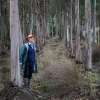
Bioenergy: Fuelling industries with trees
Posted 16 May 2024
Economic benefits and markets Tree Alliance
Bioenergy is a sustainable alternative to fossil fuels. It is typically generated from organic waste from agricultural, municipal, industrial and forestry sources. That means it helps to manage waste while providing a renewable source of fuel in a carbon neutral economy.
We spoke to Martin Moroni from the Tasmanian Department of State Growth about bioenergy opportunities for farm forest owners.
What is bioenergy?
Trees produce organic matter known as biomass. In forestry, biomass usually comes from wood and harvest residues that would otherwise be waste. Biomass can then be converted into bioenergy.
Martin Moroni has extensive experience in Tasmanian forestry. For the last eight years, Martin has focused on developing bioenergy in Tasmania, including policy and strategy for the Bioenergy Vision for Tasmania.
"Bioenergy can be used to make any energy source, electricity, heat, cooling, transport fuels," says Martin, "it can compete with fossil fuels in every market.
"With fossil fuels, you take something from the ground that's isolated from the atmosphere, and you give it to the atmosphere.
"But trees take carbon out the atmosphere as they grow. When you burn portion of that tree, you return the carbon to the atmosphere, which then gets reabsorbed into another tree. So it's a cycle.
"Bioenergy is the largest renewable in the world. It's larger than all other renewables combined on a global scale.
"And people are moving into bioenergy for three reasons. One is that they want to decarbonise, two is that bioenergy for heat is the cheapest option and the third is for waste management.

Opportunities for farmers
So what does bioenergy mean for Tasmanian landowners? Bioenergy could bring opportunities for farmers to increase their income by selling biomass. It can also help reduce farm waste.
"In farm forestry, bioenergy provides a market for low-quality logs,’ says Martin.
‘Bioenergy can support using more of the tree, which provides a greater return to landowners and makes agroforestry plantings more profitable.
"So if there's 10 per cent or 15 per cent of the tree left behind after harvesting, there are elements that could be collected and used for bioenergy. And that might actually be the difference to make their operation economic.
"Farmers who want to sell their wood talk about selling sawlogs or chips. Now they can also start talking about selling fuel logs. It won’t be a large proportion of the harvest, but it will be the icing on the cake.
"Society needs sawlogs and good quality logs for other purposes. But many logs that might go into woodchips or defect logs can go to a nearby boiler. Certainly this is happening in Tasmania, so it’s all very possible."
A growing market
Bioenergy is a developing market in Tasmania. State and national governments have announced investments in this alternative energy source. Martin says there are many companies looking to use bioenergy in new ways across the state.
"Tasmania has an enormous opportunity to expand bioenergy," says Martin. "Bioenergy is about 5 per cent of Australia’s total energy production, but with our existing forest sector, we can get to about 30 per cent.
"Tasmania is getting new boilers installed already and there’s talk of several other companies wanting to move into bioenergy. So opportunities are growing.
"What’s really going to really require a lot of biomass is transport fuels. We’ve got companies in Tasmania looking to make methanol and they won’t just be looking for bioenergy for heat. It will be fuel for cars, boats and aeroplanes. And they will look for very large volumes.
"If those operations get up and running, there'll be significant opportunities for Tasmanian farmers to provide wood into that market. Bioenergy is really about understanding what’s possible."
Accessing the market
As the market develops in Tasmania, Martin encourages farmers to be proactive in identifying opportunities. Creating connections with local boilers is a great place to start.
"If landowners are near a boiler using wood, they can have a discussion with that boiler owner about integrating their wood into the supply chain.
"So you could end up with farmers that have more economic agroforestry because they can sell their wood directly to a nearby boiler.
"As the bioenergy market expands and the supply chain becomes more developed, a group of farmers could even identify a fossil fuel boiler nearby. They could encourage it to swap over to biofuel, saying they will put in trees as feedstock for that boiler.
"So it's really about landowners keeping an eye on these things and talking to companies using biofuels to see if they can get their product into the supply chain. It's about becoming a bit creative."
Learn more about the potential of bioenergy with the Tree Alliance Knowledge Hub. Visit www.treealliance.com.au.






